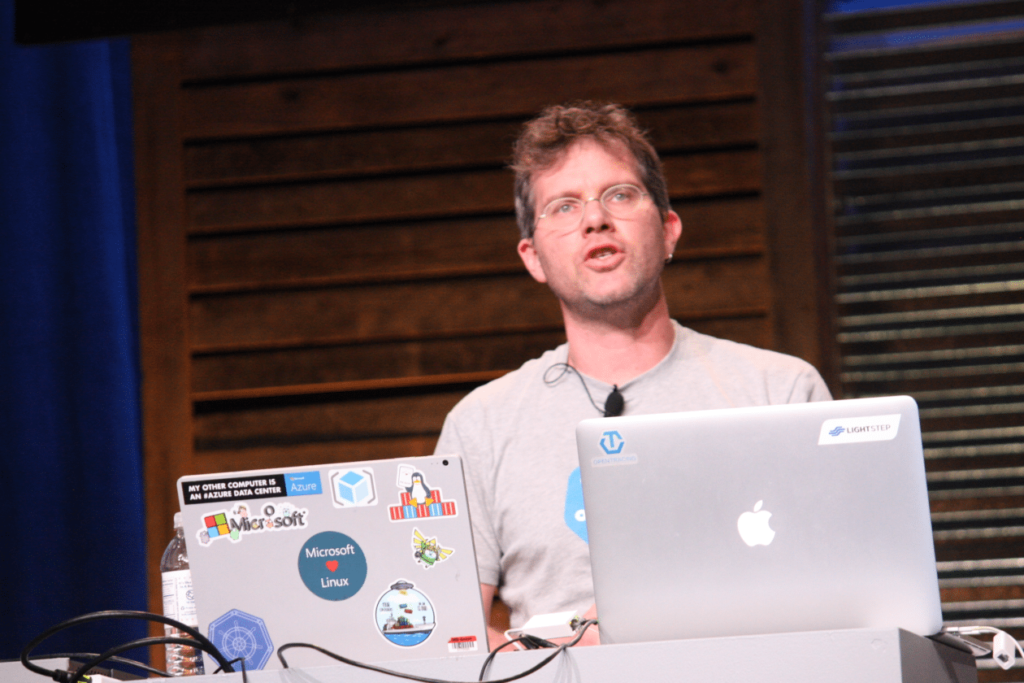Today, we announced that Azure Kubernetes Service, which simplifies the deployment, management, and operations of Kubernetes, is now generally available in five new regions. I sat down with Brendan Burns, co-founder of Kubernetes, to get a behind-the-scenes look at the service, as well as what’s new and what’s next with the Kubernetes community.

Q: Where does Kubernetes stand today?
Brendan: Kubernetes is ubiquitous, it’s available as a service in all of the major public clouds, it’s become something developers can take for granted and build on top of, no matter where they want to run them. This is really fantastic, because it means we can start building on top of the Kubernetes API, with confidence and knowledge that solutions we build can reach developers everywhere. Kubernetes was never intended to be the final product, and I’m super excited about all of the things we’re building on top of Kubernetes to make it easier for developers of all skill levels to build, deploy and manage reliable distributed systems.
Q: What should we use Kubernetes for?
Brendan: Everything! I think Kubernetes is really well suited to a wide variety of applications from reliable APIs to machine learning or big data. That said, Kubernetes can be a little complicated if you are just trying to build a simple static web app, so sometimes it makes sense to consume Kubernetes via a tool like Helm that makes it super easy to deploy and manage existing “off the shelf” open source software like MongoDB or WordPress.
Q: Why do you think Kubernetes won in the container orchestration space?
Brendan: I really think it was the strength of our community, we’ve always been super open, really welcoming to everyone who wanted to come and work on this project. All of these people came and helped us learn from their various different perspectives and all of that learning helped us develop a system that is pretty useful to a lot of people. I think that spirit of openness, learning and growth really set the Kubernetes community apart, and Kubernetes, the orchestrator, is better because of the contributions of its community.
Q: What do you think Azure did differently than other clouds?
Brendan: I think there are a couple of real strengths that differentiate Azure and Azure Kubernetes Service (AKS). First, it’s the focus on enabling and empowering all sorts of different developers. Kubernetes can be complicated to approach at first, and I think with tools like Draft, Brigade, Helm and our plugin for Visual Studio, we’re enabling developers to gradually learn how to use and debug Kubernetes applications at a pace that works for them. The heritage of empowering developers runs deep and Microsoft and I think it sets us apart. I also think Azure has a unique knowledge of the requirements of the enterprise, and I think this shows in AKS with features like Azure Active Directory integration and ARM Policy enforcement.
Q: How do we keep the spirit of Open Source K8S while having AKS for Azure?
Brendan: I think there are a couple of different answers here. The first is that it’s important to give back to the Kubernetes community. You see us doing this via leadership in SIGs and on myself and Michelle Noorali on the Kubernetes Steering committee. I also think you see this in the fact that a portion of my team is dedicated solely to working in the upstream kubernetes repository, building features that work for all Kubernetes users, not just those on Azure. Finally, I think you see this in the tools that we build to make Kubernetes easier. Helm, Draft, Brigade and our VS Code Extension all work with Kubernetes clusters everywhere. Of course we make them work awesome with Azure and AKS, but users can take advantage of our tooling improvements no matter where they run Kubernetes. We’re pushing the fore-front of Kubernetes and Serverless technology with our community work on the Virtual Kubelet. It’s early days, but we’re exploring cutting edge pieces of what may be the future for Kubernetes. Finally, with our work on the Open Service Broker API and Open Service Broker integration in both Kubernetes and Azure we’re helping lead the way so that developers can access cloud APIs through portable APIs.
To maintain a spirit of openness, it’s really important to work the existing projects, and also build new things that the entire community can take advantage of. You can’t just consume open source projects, it’s critically important that you give back as well.
Q: What do you see as the trends for Kubernetes in the future?
Brendan: I’m kind of hoping that people stop thinking about Kubernetes so much. I kind of feel like Kubernetes is the assembly language for Cloud Native applications. I hope, in five years, we think of Kubernetes kind of like we think of the x86 or ARM assembly language. Sure, it’s there running underneath our programs, but on a day-to-day basis we consume higher level abstractions that make us more productive as developers and operators of applications. With Kubernetes we’ve laid the foundation of a truly cloud-native runtime, but we’ve got a lot of work ahead of us to build the right programming models that make it easy for everyone to consume.
